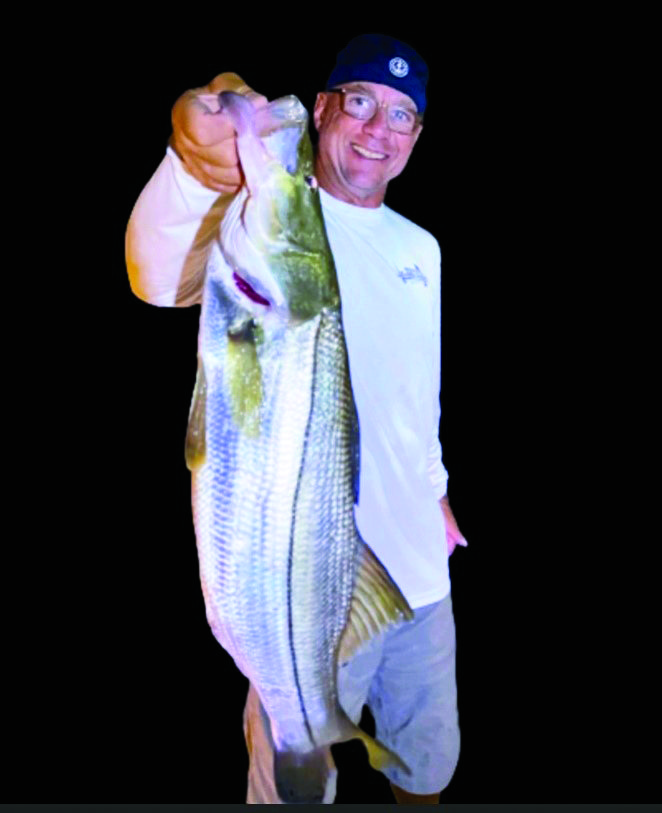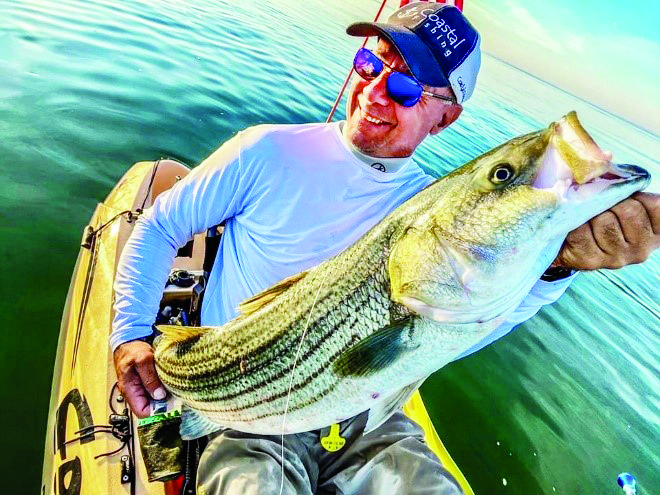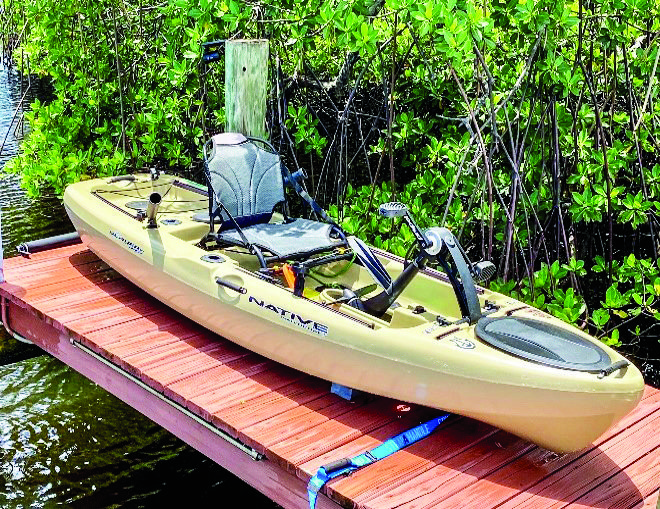By Mark Ambert Contributing Writer

I’ve spent a good portion of my adult life fishing from a kayak. It’s the mode of transport that makes the most sense when targeting inshore species. I cut my teeth fishing in this manner for stripers in the northeast. I developed somewhat of a reputation, catch and release of the big old gals in excess of forty pounds fishing places that boaters and shore fisherman only dreamed of reaching. I humbly joined the over fifty club in a kayak! Nothing beats the thrill of a Nantucket sleigh ride courtesy of a big fish. Having moved here to Florida, a logical target for kayak fishing is the snook. Every bit as large and powerful as the striped bass and with a similar fighting style and habitat. I wanted to see if I could adapt my methods and be a successful snook angler!

For me, the place to start for big snook would be nighttime fishing but first I had to learn the terrain. I spent many hours peddling my Native kayak scouting for local hotspots during the day. This included docks, bridges, seawalls – any place ideal for an ambush! The few times I ventured out around dusk I noticed a definite pattern. Once the dock or bridge abutment lights came on it was like ringing the dinner bell – baitfish along with big snook and the occasional school sized tarpon would begin to show. Nighttime definitely seemed right for snook!

I began targeting and fishing these areas during the day to get familiar with the fishery. I began scouting the flats, grass beds, mangroves, and shoreline in search of bait patterns. Wherever there’s bait, big fish will be present.
Pro Tip – when fishing along the mangroves during the day, I prefer an outgoing tide that’s at least halfway out. This moves the bait and bigger fish from under the overhang into the first trough that develops right in front of the mangroves. Fish will use this drop-off area as a highway which congregates bait being washed out from under the shoreline growth.
I especially targeted areas that were in the ICW (Intracoastal Waterway) high speed zones having noticed most fisherman don’t like to fish there due to the constant boat wakes from passersby. Most of these areas were very lightly fished if at all.

Because snook are ambush feeders, I would capitalize on the boat wakes by timing their arrival at the docks, pilings or seawalls and casting to the structure. Not being strong swimmers, the wake would throw the bait into total disarray and the snook were there to capitalize. The confused baits were easy targets big fish just couldn’t refuse. If correctly timed these casts during boat wakes almost always produced a fish. My go to lure for this type of fishing is the Rapala X-Rap series in size 8 and 10. My favorite color is ghost for both day and nighttime.
Pro Tip – I replace the hooks on my lures with 4X strong Stinger Trebles from Owner. This adds the holding power needed to stop big fish heading for structure.
After several weeks of careful scouting and landing several decent slot-sized snook I was ready to tackle the night fishery. I began by targeting the local bridges but only during the week when boat traffic was at a minimum. I wear an inflatable life jacket and always use a safety flag and lights when fishing at night. Stay out of the channels and move close to the shoreline if a boat happens to approach – be sensible and safe! When approaching the bridge look for any lights used to mark the abutments. Fish both sides and on both the outgoing and incoming tides. With snook, current is everything, so I like to target the three-hour window covering a tide transition. By this I mean the period leading up to and just after the tide change. Either low to high or high to low tide – both present different opportunities. Snook will always sit with their noses into the current waiting for bait to be swept by. Target fish that are drawn to the light using a quality imitation like the Rapala X-Rap. I like using artificials better than bait as you can put the imitation exactly where you need it and where a hungry snook is sure to bite. Work the lure as close to the structure as possible. Vary between a moderate speed steady retrieve and a fast twitch retrieve to induce a reflexive strike. Both work well. Keep the lure swimming just ahead of the current. I like the larger X-Rap when targeting bridges and deeper drop-offs. It provides a bigger profile in open water. When fishing dock lights, I use the smaller X-Rap. These lights are usually in tighter to the dock or shoreline and in shallower water and are likely targets for scouting anglers. Casting a heavier lure is a sure way to spook the fish.
Once hooked up move the fish off existing structure as quickly as possible. Have the drag set tight – use the maximum amount of pressure appropriate to your gear.
Pro Tip – I use 40lb braid with a 30lb fluorocarbon leader along with a 7’ medium action rod. A Penn Battle with the HT-100 drag system provides the stopping power.
If a big snook turns and gets his tail behind him heading for structure the fight is lost. This is where a kayak with peddle drive comes in handy. Having the ability to peddle backwards to provide instant reverse is an incredible advantage in a close quarters fight! My Native kayak has this feature and has saved the day numerous times when snook fishing. Use this capability to draw the fish out quickly and away from any impending structure. Remember – the same spots that hold fish at night usually produce during the day.
After one or two fish are pulled from a light, give the area a rest. Usually, the fish will settle down after 20 minutes or so. Target two or three other locations then cycle back on the trip home.
Nighttime can be peaceful and provide many rewarding experiences if approached correctly. Enjoy your quiet time on the water and spend the evening with a big snook!
Note – Please check current regulations on seasons and slot sizes as they frequently change.
Mark Ambert – Avid outdoorsman, sportswriter & photographer
Follow me on Instagram @marksgonefishing or contact me at
marksgonefishing@gmail.com for collaboration
